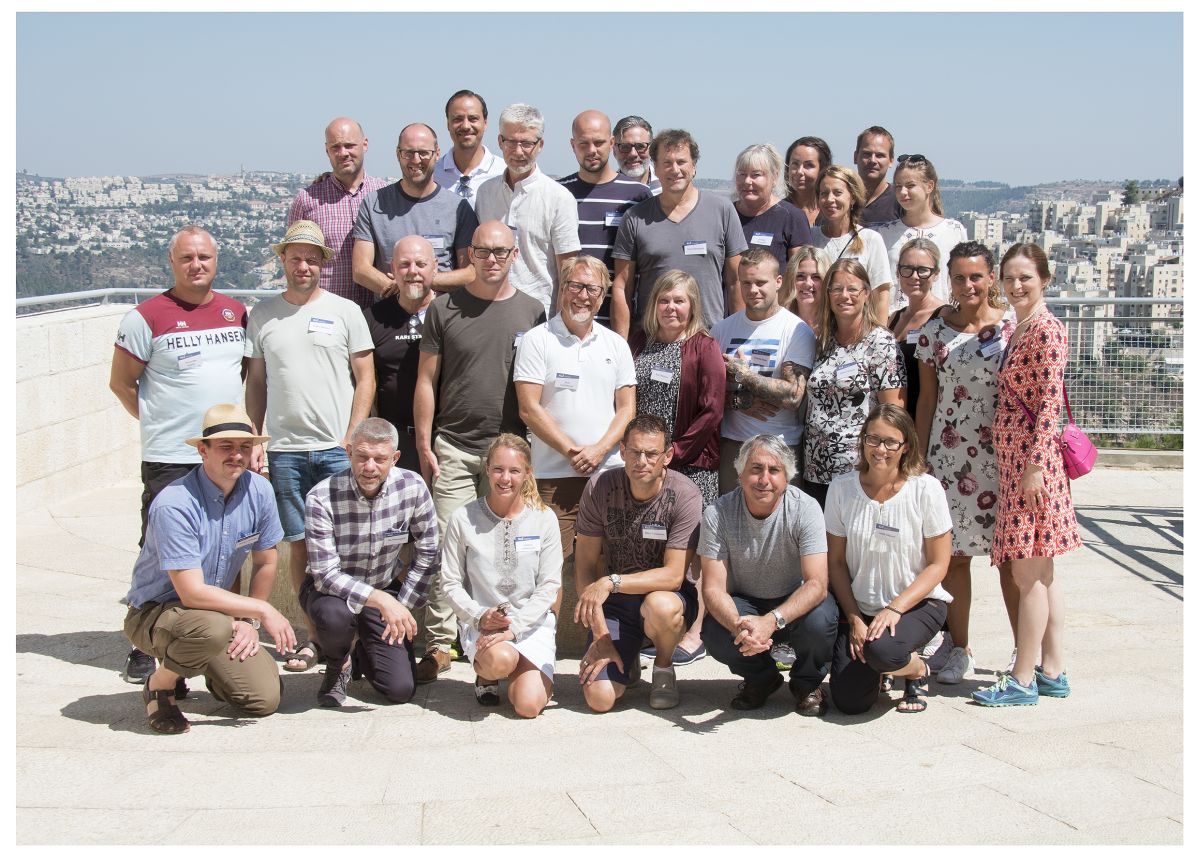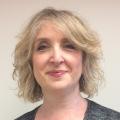
A group of Swedish Teachers participate in an Educational Seminar at Yad Vashem 2017
"I grew up in a pretty normal family – a mother and five siblings – but in a xenophobic environment. My older brother was in the neo-Nazi movement, my mother was a xenophobe, my grandfather was a Nazi in the 1940s. That is my family story."
So recalled Peter Sundin, a participant of a recent seminar at Yad Vashem for Swedish educators. Sundin and a colleague who also hailed from a neo-Nazi background joined 25 teachers who came to the Mount of Remembrance to learn more about the Shoah and acquire effective tools for educating Swedish youth of its relevance today.
Sundin got involved with the neo-Nazi movement in his hometown at the tender age of 14. "My school noticed that the movement was growing and decided to invite a Holocaust survivor to speak to the students," he recalled. Before the assembly, the teacher singled out Peter and nine other students believed to be sympathetic to neo-Nazism and made them sit in the first row. "I remember sitting there, feeling nothing. Afterwards, in class, we were told to draw our feelings. Some of the other kids were crying. When it was my turn to speak, I heard my brother's voice telling me that the Holocaust was fake. I drew a swastika, held it up and shouted, "It’s a fairytale!" and ran out of the classroom. I didn't go back for three days. I felt that the school had targeted me and the other boys, and I decided that if they saw me as a National Socialist, I would be one."
Sundin finally quit the movement after taking part in a particularly violent attack against a young immigrant."I emailed the organization with two words: 'I quit.' The hardest thing was that I also had to leave some of my family behind. I haven't spoken to my older brother since that day – eleven years ago. At first, I thought my exit process would be easy. However, I soon realized that my racist ideologies were not in the papers I had read or the pamphlets I had distributed, but deep inside me. That was scary. "
In 2012, Sundin met Christer Mattson – a well-known Swedish leader who has worked with former neo-Nazi leaders for the past 20 years and now heads the Swedish "Tolerance Project" that helps educate students and teachers alike about the dangers of hate and xenophobia. He told Mattson his story, and began working with youth involved in xenophobic movements. "The Tolerance Project changed my life," he states. "I've been to Poland twice and now I am here in Israel at Yad Vashem because I feel it is the best education I can get."
Every year hundreds of educators from around the world journey with this same open mind to participate in seminars at Yad Vashem. For nearly a half a century, Yad Vashem has been the leading institution in shaping the way the public is educated about the Holocaust. Every year, thousands of educators and community leaders come to draw on Yad Vashem's unique approach to Holocaust education and use these skills back in their home countries. Yad Vashem also has official agreements with dozens of countries who send their teachers to Israel to participate in these important teaching courses.
When it comes to the Holocaust, however, Sweden has a complicated history. Wishing to remain neutral during WWII, the Swedes acted more pro-German in the early years, but supported the policies of the Allies as Germany began to lose ground. As Sweden's attitude towards the Germans changed during the war, so did their attitude towards refugees. With a prewar Jewish population of just 7,000, Sweden took in more than half of Norway's Jewish community, some 900 people fleeing Nazi deportations, as well as 7,000 Danish Jews who were famously rescued by boat. In 1944, Swedish diplomat Raoul Wallenberg and his staff, along with the Swedish Red Cross, rescued thousands of Hungarian Jews.
Near the end of the war, Sweden sent food packages to Jews in concentration camps, such as Bergen-Belsen. Additionally, Count Folk Bernadotte of the Swedish Red Cross managed to transfer the last 14,000 women in the Ravensbrueck camp, including 2,000 Jews, to Sweden. After the war, Sweden absorbed thousands of survivors and did everything possible to help them start new lives.
Nevertheless, as a relatively "side-player" in the war, for decades afterwards the general Swedish population received scant knowledge about the Shoah. In the 1990s, with Sweden's desire to join the European Union and the rise of the fascist National Socialist movement, the Swedish government understood more had to be done about Holocaust education. Consequently, in 1998 Prime Minister Gören Persson spearheaded a Swedish campaign, the Living History Forum, and began to foster education about the Holocaust within its own borders and throughout the world.
And yet, this wasn't enough. Neo-Nazis gathered greater and greater numbers, among the youth especially. Holocaust denial, as well as other racist and xenophobic ideologies and acts, lay high on their agenda. Following the shocking murder by four neo-Nazis of a Czech immigrant teenager in 1995, the Tolerance Project was born, in an attempt to identify, work with, and eventually turn around at-risk youth caught up in fascist movements.
Kimmie Åhlén, another participant in the Swedish educators' seminar with a neo-Nazi past, came to Yad Vashem because of his complicated personal history. He began to identity with the local skinhead movement at the age of 12. By 14, he was fully indoctrinated and ideologically aligned as a National Socialist. Involved in a culture of alcohol and drug abuse and committed to violence and fighting "communists" and immigrants, Kimmie was on the fast track to the top of the neo-Nazi Movement. "I was someone. I had an identity. I wasn't a young bullied kid any longer… I felt like a man with something to believe in."
In school, he denied the Holocaust, telling his teachers that he didn't believe in it because Jews and Jewish culture was the biggest enemy of National Socialists.
By 17 Åhlén was the leader of local National Socialists chapter. He was later imprisoned for almost two years. When he came home, "I decided to rethink life and, figure out what went wrong.
"While in prison I remembered meeting a great teacher who I had the opportunity to talk to at length about homosexuality – which I hated, the Holocaust – which I denied, and immigrants, especially Muslim immigrants, which I didn't like."
Åhlén got involved with the Tolerance Project after revisiting a Jewish graveyard in Karlstaad (where 500 Jewish women went to recuperate after the war). When he first visited the site, he was convinced that there were really no Jews buried there. But under Mattson's guidance, his horizons opened and he realized he wanted not only to increase his knowledge on the Holocaust but also understand why and how it happened. He is especially inspired by hearing survivor testimony at Yad Vashem. "As I work with young people, using first-hand stories of Holocaust survivors is a way to bring history to life and create sympathy for the victims."
Social Science Teacher Helena Hermansson agrees. "Swedish teachers are obliged to teach about the Holocaust in particular, as well as other genocides. In theory, all students should learn about the Holocaust before secondary school. But Swedish teachers need to learn more about how to teach the Holocaust. The Tolerance Project actually has a lot in common with Yad Vashem's pedagogy. Students should see history as an ongoing process, learning from the past, and seeing the individuals behind the stories. In this way, students learn that their choices can make a difference."
History Teacher Ola Flennegard has been dealing with Holocaust education since 2001 and was interested in coming to Yad Vashem in order to deepen his understanding of the events of the Holocaust, as well as to learn about its didactic approaches to Holocaust education. "Without profound knowledge about the Holocaust, we cannot encounter neo-Nazis or neo-Nazism. Superficial knowledge can be catastrophic. The preservation of memory at Yad Vashem is so evident and on a high level… we need to move away from linear teaching to learning about what happened before and after – to give more of a perspective to the event. The Holocaust was not only, or even mainly, about the camps, but about the hole in Europe that needs discovering – six million people. If you know where to look you can find traces of what was.
"You can't be a European and not want to teach about the Holocaust, and show your students the loss it caused of human values in Europe. It is not enough to appreciate what was lost – we need to understand that human beings were behind the loss and they were born no different to us. If you want to understand what it means to be a human being, you have to come to Yad Vashem."










